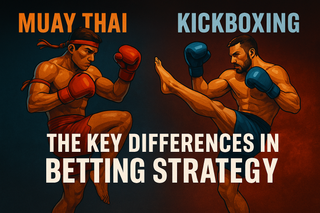When it comes to combat sports betting, lumping Muay Thai and kickboxing into the same category is a rookie mistake. While both are striking arts with international followings, the rules, pace, scoring systems, and fighter tendencies differ—meaning your betting approach needs to shift accordingly.
1. Tools of the Trade: 8 Limbs vs. 4 Limbs
• Muay Thai allows punches, kicks, elbows, and knees—hence the “Art of Eight Limbs.”
• Kickboxing is more limited, typically allowing just punches and kicks, and sometimes knees (depending on the promotion). Elbows and prolonged clinching are usually banned.
Betting Impact: A Muay Thai fighter can win rounds by dominating the clinch with knees and elbows. If you’re betting a points-based prop or decision outcome, weigh clinch control heavily in Thai bouts.
⸻
2. Scoring Systems: Round-by-Round vs. Overall Impression
• Kickboxing often uses a 10-point must system, like boxing and MMA.
• Muay Thai (especially in Thailand) uses a unique scoring method: later rounds weigh more, and aesthetics like composure and control influence judges.
Betting Impact: A fighter losing early rounds in Muay Thai might still pull off a decision win with a dominant 4th and 5th. Live betting or comeback props can carry more value here.
⸻
3. Pace and Volume: Fast-Paced vs. Calculated Starts
• Kickboxing is often high-paced from the first bell.
• Muay Thai bouts tend to start slow, with rounds 1–2 being more like feeling-out rounds.
Betting Impact: Don’t rush to live bet after Round 1 of a Muay Thai fight. Fighters often hold back until the later rounds. However, if a kickboxing bout starts wild, early stoppage props may offer better returns.
⸻
4. Regional Variations Matter
• In Thailand, Muay Thai bouts are steeped in tradition and often cater to scoring preferences that differ from international promotions.
• Kickboxing under GLORY, K-1, or ONE Championship can vary in pace, ruleset, and even glove size.
Betting Impact: Always check the promotion’s ruleset. For example, ONE’s Muay Thai in 4oz gloves behaves very differently from traditional stadium Thai fights in 10oz gloves.
⸻
5. Prop Bets: What Makes the Most Sense
• Muay Thai: Look at decision props, especially in Thai stadium fights, unless there’s a big mismatch in clinch skill.
• Kickboxing: Round betting or KO/TKO props are often more relevant due to higher pace and fewer clinch interruptions.
⸻
Final Take
To win long-term in combat sports betting, you need to treat Muay Thai and kickboxing as different beasts. Each discipline requires its own tape study, ruleset awareness, and pacing analysis.
Whether you’re backing a seasoned nak muay or a fast-paced kickboxing striker, smart bettors always adjust to the fight style—not just the name on the card.





